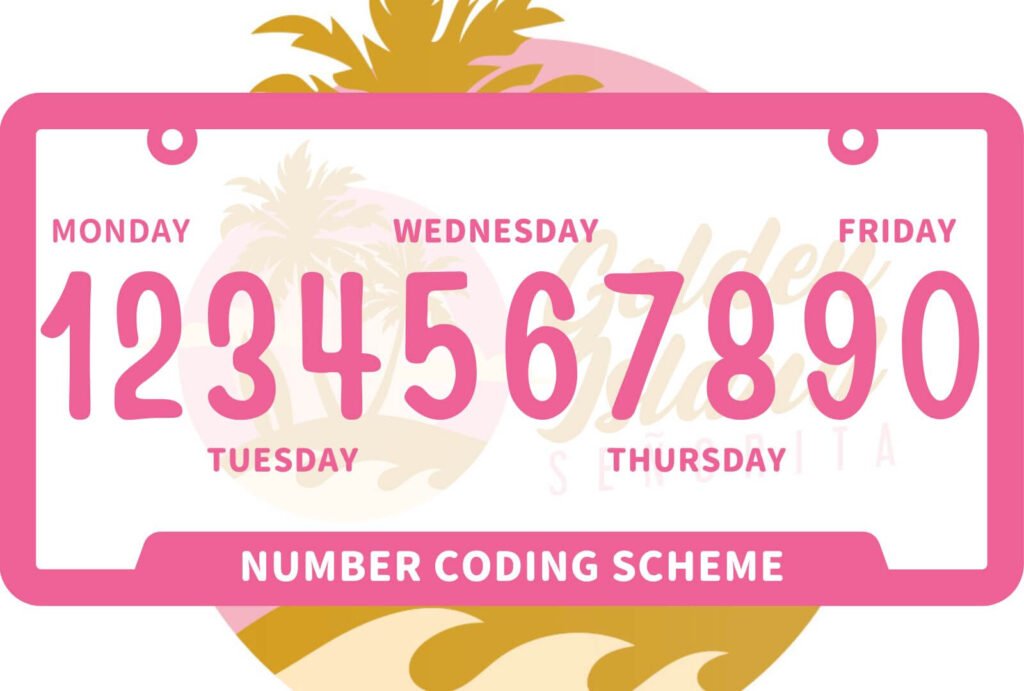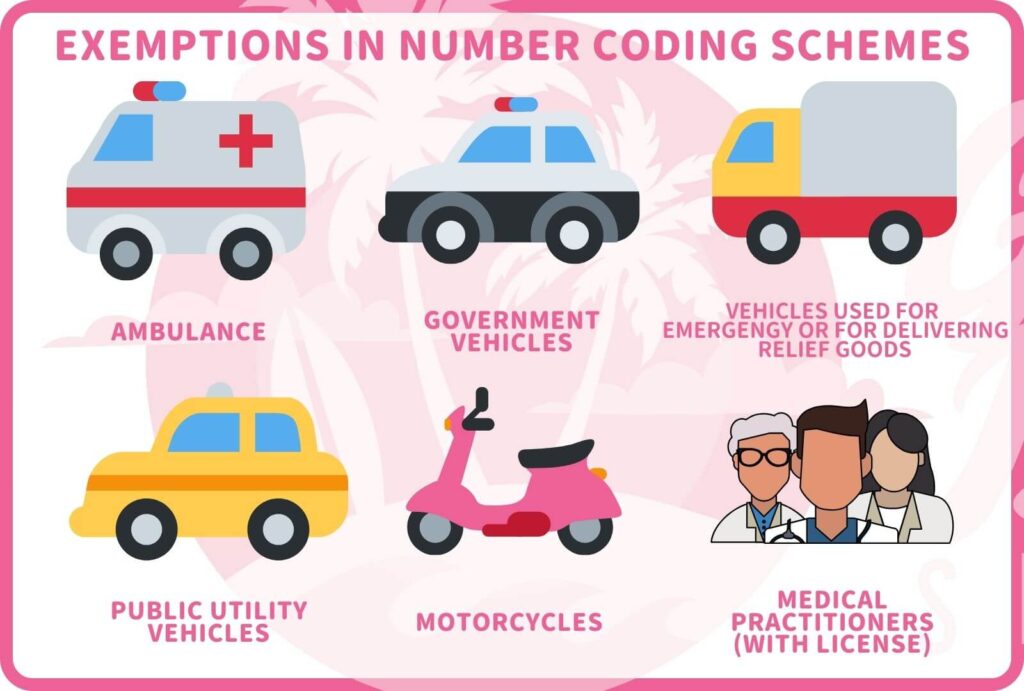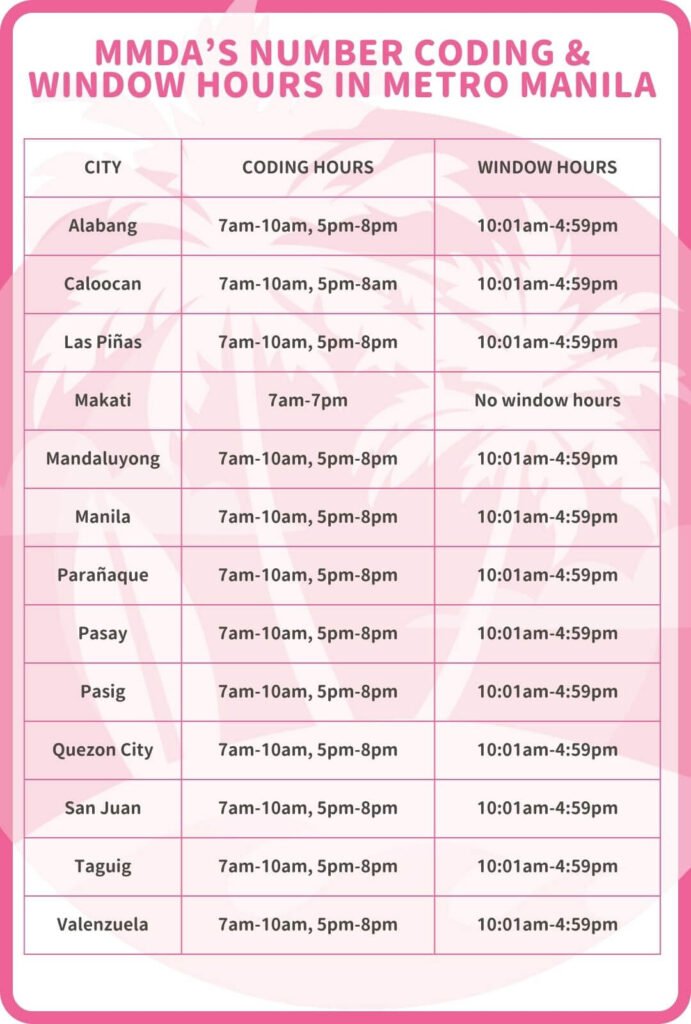Metro Manila, the bustling capital region of the Philippines, is infamous for its traffic congestion issues. To address this concern and manage the flow of vehicles more effectively, the government implemented the Number Coding Scheme, also known as the Unified Vehicular Volume Reduction Program (UVVRP). In this article, we delve into the details of this scheme, addressing commonly asked questions to provide a clearer understanding for motorists and residents alike.
1. What is the Number Coding Scheme in Metro Manila?
The number coding scheme, or UVVRP, is a traffic management measure enforced in Metro Manila to reduce the volume of vehicles on the roads during peak hours. Under this scheme, vehicles are prohibited from operating within specified areas on certain days, based on the last digit of their license plate number.
2. How Does the Number Coding Scheme Work?
Under the Number Coding Scheme, vehicles with license plate numbers ending in particular digits are prohibited from plying Metro Manila roads on certain days. The scheme operates from Monday to Friday, excluding holidays, during specific hours, usually from 7:00 AM to 8:00 PM. Each day is assigned a set of numbers that are not allowed to traverse the roads during the designated time frame.
3. Who Implements the Number Coding Scheme?
The implementation of the Number Coding Scheme in Metro Manila is a collaborative effort involving various government agencies, primarily the Metropolitan Manila Development Authority (MMDA) and local government units (LGUs) within the National Capital Region (NCR). These agencies work together to enforce the scheme’s regulations and ensure compliance among motorists.
4. Which cities in Metro Manila are covered by the number coding scheme?
The number coding scheme covers all cities within Metro Manila, including Quezon City, Manila, Makati, Pasig, Taguig, Mandaluyong, San Juan, Muntinlupa, Las Piñas, Parañaque, Valenzuela, Navotas, Malabon, and Caloocan.
5. What are the objectives of the number coding scheme?
The primary objectives of the number coding scheme are to reduce traffic congestion, improve air quality, and promote the efficient use of road infrastructure in Metro Manila. By restricting the movement of vehicles on certain days, the scheme aims to encourage the use of public transportation and reduce the overall volume of cars on the roads.
6. What vehicles are covered by the number coding scheme?
The number coding scheme applies to all private and public vehicles, including cars, vans, trucks, and motorcycles, registered in Metro Manila.

7. What Number Plates are Allowed and Not Allowed?
To clarify, let’s break down which number plates are allowed and not allowed on each day:
- Monday: Vehicles with plate numbers ending in 1 and 2 are not allowed.
- Tuesday: Vehicles with plate numbers ending in 3 and 4 are not allowed.
- Wednesday: Vehicles with plate numbers ending in 5 and 6 are not allowed.
- Thursday: Vehicles with plate numbers ending in 7 and 8 are not allowed.
- Friday: Vehicles with plate numbers ending in 9 and 0 are not allowed.
For example, on a Monday, vehicles with license plate numbers ending in 1 or 2 cannot operate within Metro Manila during the specified hours. Similarly, on a Tuesday, vehicles with plate numbers ending in 3 or 4 are restricted, and so forth.

8. What are the exempted vehicles from the number coding scheme?
Certain vehicles are exempted from the Number Coding Scheme. These include:
- Emergency vehicles such as ambulances, fire trucks, and police cars.
- Government vehicles with official government plates.
- Medical practitioners’ vehicles with official medical practitioner plates.
- Diplomatic vehicles with diplomatic plates.
9. What are the covered days and hours of the number coding scheme?
The number coding scheme is implemented from Monday to Friday, excluding holidays, during specified hours. Generally, vehicles with license plate numbers ending in specific digits are not allowed on the roads from 7:00 AM to 8:00 PM. However, the exact schedule may vary depending on the city and specific regulations.

10. What is ‘Window Hours’ and how is it currently being implemented?
Window Hours refer to a specific period during which vehicles covered by the scheme are exempted from the coding restrictions. This designated time frame allows motorists to use their vehicles even if their license plate numbers are subject to the coding scheme on a particular day. The Window Hour aims to provide flexibility for commuters, particularly during off-peak hours, while still effectively managing traffic congestion.
Example: Suppose it’s a Monday, and vehicles with license plate numbers ending in 1 and 2 are subject to the coding scheme restriction. Typically, these vehicles are not allowed to operate within Metro Manila from 7:00 AM to 8:00 PM on Mondays.
However, during the Window Hours, which may occur during off-peak hours such as late at night or early in the morning, the restriction is lifted. For instance, if the Window Hour is set from 10:00 AM to 3:00 PM, vehicles with plate numbers ending in 1 and 2 can freely travel within Metro Manila during this time frame, despite the coding restrictions in place for that day.
This allowance during the Window Hour provides motorists with the flexibility to conduct essential activities or travel to their destinations without being unduly constrained by the coding scheme. It also helps distribute traffic volume more evenly throughout the day, contributing to smoother traffic flow and reduced congestion during peak hours.
11. What are the penalties for violating the number coding scheme?
Violating the number coding scheme may result in fines or penalties, which vary depending on the city and the frequency of the offense. Penalties may include monetary fines, impoundment of the vehicle, or attendance in a traffic seminar.
12. Is there a fine or penalty for violating the number coding scheme?
Yes, there is a fine or penalty for violating the number coding scheme. The amount of the fine may differ depending on the city where the violation occurred.
Penalties and Fines
Violating the Number Coding Scheme in Metro Manila may result in penalties and fines imposed on erring motorists. The exact penalties vary depending on the severity and frequency of the offense, as well as the discretion of the enforcing authorities. Typically, the penalties for violating the scheme include:
- Monetary Fines: Motorists found in violation of the Number Coding Scheme may be issued a citation ticket indicating the offense committed. The fines imposed can range from a few hundred to several thousand pesos, depending on the city and the specific circumstances of the violation.
- Impoundment of Vehicles: In certain cases, particularly for repeat offenders or serious violations, authorities may opt to impound the vehicle involved in the offense. Impoundment entails the temporary confiscation of the vehicle and may require the payment of additional fees for its release.
- Attendance in Traffic Seminars: Some LGUs offer alternative penalties, such as mandatory attendance in traffic seminars or road safety awareness programs, in lieu of or in addition to monetary fines. These seminars aim to educate motorists about traffic rules and regulations, fostering responsible driving behavior.
Enforcement of Penalties
The enforcement of penalties for violations of the Number Coding Scheme is carried out by traffic enforcers deployed by the MMDA and LGUs across Metro Manila. These enforcers patrol major thoroughfares, intersections, and designated checkpoints to monitor compliance with the scheme’s regulations. Upon identifying violators, they issue citation tickets specifying the offense committed and the corresponding penalties.
Appeals and Dispute Resolution
Motorists who believe they have been erroneously cited for violating the Number Coding Scheme have the right to appeal the citation and dispute the charges. The process for appealing a citation may vary depending on the LGU issuing the ticket, but it typically involves submitting a formal appeal or attending a hearing to present evidence supporting the motorist’s case.
13. How do I know if my vehicle is exempted from the number coding scheme?
You can determine if your vehicle is exempted from the number coding scheme by checking its license plate number and verifying if it falls under any of the exempted categories mentioned earlier.
14. Can I request for exemption from the number coding scheme for a specific reason?
In some cases, individuals may request exemptions from the number coding scheme for specific reasons, such as medical emergencies or official duties. However, such requests are typically subject to approval by the relevant authorities.
15. How often does the government review or update the number coding scheme?
The government periodically reviews and updates the number coding scheme to ensure its effectiveness in addressing traffic congestion and adapting to changing circumstances in Metro Manila.
16. Are there any changes or adjustments to the number coding scheme during holidays or special occasions?
Yes, there may be changes or adjustments to the number coding scheme during holidays or special occasions. In some cases, certain vehicles may be exempted from the scheme to accommodate increased travel demand during these periods.
17. Can I still drive within Metro Manila if my vehicle is covered by the number coding scheme on a particular day?
If your vehicle is covered by the number coding scheme on a particular day, you may still drive within Metro Manila, but you must observe the designated hours and areas where the scheme is enforced.
18. Are there alternative modes of transportation provided during the number coding scheme implementation?
To mitigate the impact of the number coding scheme on motorists, various alternative modes of transportation are available in Metro Manila, including buses, trains, and ride-hailing services. Additionally, carpooling and cycling are encouraged as alternative options for commuting.
Conclusion
The number coding scheme in Metro Manila serves as a crucial tool in managing traffic congestion and promoting sustainable transportation practices in the region. While it may inconvenience some motorists, its overarching goal of improving mobility and reducing pollution underscores its importance in the urban landscape. By understanding its mechanics and adhering to its regulations, motorists can contribute to a smoother and more efficient traffic flow in Metro Manila.

